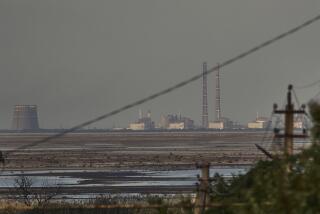Q&A: What’s happening at Japanese nuclear plants?
Two nuclear power plants operated by Japan’s Tokyo Electric Power Co. are experiencing cooling problems with their reactors after Friday’s massive earthquake, triggering one evacuation so far with another likely coming soon. Two reactors at the company’s Fukushima No. 1 plant are affected, along with three at Fukushima No. 2. The power plants are about 150 miles north of Tokyo.
Although the situation is fluid and conflicting reports are coming from the sites, here is the best information available now.
What happened?
Shaking from the magnitude 8.9 quake caused the reactors’ control rods to be inserted into the core, a safety precaution that shut down the reactors’ ability to generate electricity. The cores remained very hot, however, and would boil away all the cooling water within an hour unless the water were continuously circulating through the reactors’ cooling towers. But the tsunami also destroyed the electrical grid that would provide power to the cooling pumps and disabled the backup diesel generators that were supposed to kick in if that happened. That left only batteries to run the pumps.
Photos: Scenes from the earthquake
How long will the batteries last?
The batteries have a life of about eight hours. Japan’s nuclear and industrial safety agency said Friday that it had procured six extra batteries and that the heavy batteries might be flown in by military helicopters.
What is happening now?
No one really seems to know. News reports indicate that pressure is building inside the reactors’ containment buildings and is now about 50% greater than normal. That means the water is either boiling or at a sufficiently high temperature for it to be evaporating rapidly. News reports from the No. 2 plant say the water is boiling. Authorities are planning to vent some steam from the No. 1 plant into the atmosphere to relieve pressure inside the building. Otherwise, the pressure could build up so much that it would cause an explosion, which would be much more dangerous.
Is the radiation release dangerous?
Authorities say no, but they have evacuated everyone who lives within a 6-mile radius of the Fukushima No. 1 plant. No evacuation orders have been announced for the area around Fukushima No. 2, which is seven miles up the coast from No. 1, but that seems likely to occur as well.
A similar venting of radiation occurred in the 1979 partial meltdown at Three Mile Island in Pennsylvania, and no health effects were associated with it.
Has there been radiation leakage?
That’s not clear. There have been conflicting reports. Some reports in Japanese media suggest that levels of radiation outside Fukushima No. 1 are about eight to nine times normal, suggesting that there has been some leakage. But the baseline levels are very low, so even the elevated levels are not considered to be high.
Radiation levels inside Fukushima No. 1 have been reported to be 1,000 times normal. That is potentially concerning. But that could also be because the containment area around the reactor core is small and it has filled up rapidly with slightly radioactive steam. If that amount of radiation were dispersed over a wide area, it would most likely be negligible.
Photos: Scenes from the earthquake






